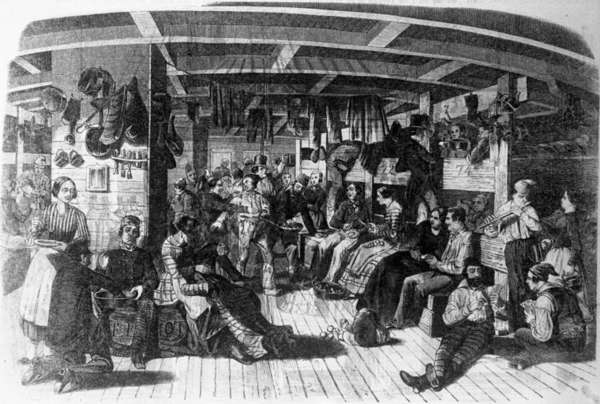Emigration from Germany: Going on a journey - costs, means of transport, and conditions of travel
- 24. April 2020 - Emigration, German-American, General, Germany, Hamburg, History, Knowledge
Going on a journey can become adventurous! When talking about ship passengers of the third class and passengers in the times when a doctor was not necessarily on board, this can be taken literally. The conditions of travel were far from comfortable and safe. But let’s take one thing at a time; no one has gone on board yet.
The two big German emigration ports were Hamburg and Bremen resp. Bremerhaven. Knowing about the rivalry between both cities in soccer, many Hamburg citizens will not like this: Bremen wins the derby between the cities clearly by 7.2 million emigrants to 5 million emigrating from Hamburg. There was a great competition and price fight not only between Hamburg and Bremen, but also between the shipping companies within both cities. Of course, this had an impact on the conditions of transport. Ships transporting emigrants sailed from cities like Szczecin (Stettin) and other smaller ports as well, but in rather insignificant numbers. Hamburg surpassed Bremen as the major German emigration port only after the implementation of steam ships.
In order to board an emigrant ship one had to able to pay for the passage in the first place. Many emigrants were agricultural laborers. Depending on the year of passage, a common laborer had to pay between two third and the tenfold of his yearly income for a ticket. It was almost impossible to put aside such a sum or to make savings with the humble income of the laborers. The only way left was to sell all of their belongings. This really only paid off when they already owned a house or land at home. Approximately half of the German immigrants hired themselves out for several years as farm hands on ranches or haciendas after their arrival in North or South America. Expenses for travel were often advanced by deals between captains and landholders and were later to be paid off by labor overseas where hands were desperately needed.
Not uncommonly, municipal treasuries paid for travel expenses. In times of great poverty and simultaneously increased growth of population, many municipalities hoped that the single payment of passage would be more profitable in the end. Making those people stay who were indeed willing to emigrate would have meant to maintain them off the poor box year after year. Sometimes, a mayor might have personally made a case for sending unwelcome residents abroad with the help of the municipal treasury.
Land barons who had someone to purchase a good piece of land overseas before selling their property at home were the exception.
For all those not being able to pay for a First or Second Class ticket, the journey was a strain. The passage to North or South America was no cruise for pleasure but a real risk. Admittedly, the supply of food was included in the price for the passage and during the first days fresh meat and fruits were available. However, because of the difficulties in storing such easily perishable foods, on most days thin soups, ship’s biscuit, dried fruit, pearl barley and pulses like peas, beans and lentils were served.
This imbalanced diet, seasickness, shortage of space and disastrous sanitary conditions resulted in severe illness and deaths while sailing. A doctor was not necessarily on board during the early years. Long after the onset of the great emigration wave, shipping companies were obliged to always send a doctor along as part of the crew.
Whoever died during the passage was buried at sea promptly. Allegedly ten percent of travelers suffered this fate. Upon arrival, those who were not on board anymore and who died, were crossed out of the passenger lists and marked as “dead”. The people in New York jokingly called the emigrant ships “coffin ships”. This was also because of catastrophes and sad affairs like the one of the sailing ship “Leibnitz”. The eleven-week-long passage from Hamburg to New York from November 1868 to January 1869 saw the death of 105 passengers from cholera. The 300 surviving emigrants were in a pitiful condition. Just as disturbing was the fate of the legendary “Cimbria”, that left Hamburg in 1883 and only made it to the East Frisian island Borkum due to a tragic accident. 437 people found their grave at the bottom of the ocean.
But likewise the number of passengers could slightly rise, if a pregnant woman was on board and her unborn baby was impatient to see the light of day.
Depending on the destination and the weather conditions, the time of travel varied greatly. To arrive at the East Coast of North America would take 29 to 77 days of sailing, reaching Brazil was possible in 42 to 97 days. The longest way was of course the one to Australia: Travelling there took between 76 and 108 days. If the journey took place via ports of call, meaning if emigrants first traveled to Liverpool or Le Havre and entered ships to their final destination there, the time of travel was extended even more. The implementation of steam ships was a great improvement towards this incalculable journey. They enabled shipping companies to offer passages at regular intervals and to sail the distance Hamburg – New York in 14 to 17 days.
Passengers, who had not booked First Class, were transported in the cargo hold. During the passage, they rarely had the opportunity to get a breath of fresh air or see sunlight from the weather deck. On top, you had to bring cookware and dishes, blankets and mattresses yourselves. Travelling with the whole family possibly including small children, having to bring household goods and beddings on top of one’s few personal belongings from home to the ship, and maybe even to a port of call, was without doubts no bed of roses. You can imagine how distressed people were at home and how much they were hoping for a better life overseas, if millions of Germans were willing to accept this ordeal.


0 comments